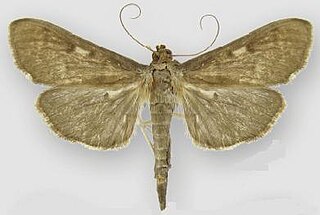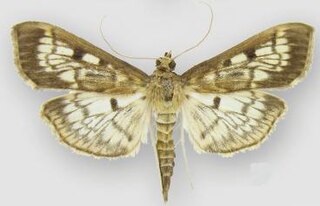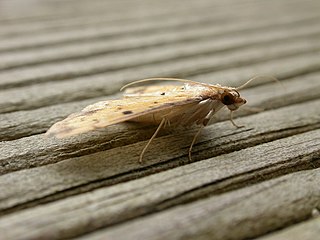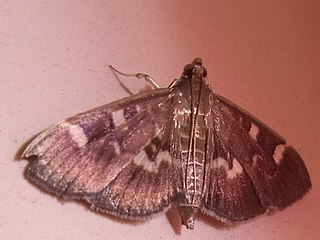
Crambidae comprises the grass moth family of lepidopterans. They are variable in appearance, with the nominal subfamily Crambinae taking up closely folded postures on grass stems where they are inconspicuous, while other subfamilies include brightly coloured and patterned insects that rest in wing-spread attitudes.

Polystichum acrostichoides, commonly denominated Christmas fern, is a perennial, evergreen fern native to eastern North America, from Nova Scotia west to Minnesota and south to Florida and eastern Texas. It is one of the most common ferns in eastern North America, being found in moist and shady habitats in woodlands, stream banks and rocky slopes. The common name derives from the evergreen fronds, which are often still green at Christmas.

Herpetogramma is a genus of moths in the family Crambidae described by Julius Lederer in 1863. It currently comprises 106 species that are found in North America, Eurasia, Australia, New Zealand, Central and South America. Of the few species where host plants are known, the larvae mostly feed on grasses.

Herpetogramma licarsisalis, commonly known as the grass webworm or pale sod-webworm, is a species of moth in the family Crambidae.

Herpetogramma sphingealis is a small species of moth in the family Crambidae. It was described as a new species in 2011.

Herpetogramma aeglealis, commonly known as the serpentine webworm moth, is a species of moth in the family Crambidae. It was first described by Francis Walker in 1859 and is found in eastern North America.

Herpetogramma thestealis is a species of moth of the family Crambidae. It is found in most of North America.

Herpetogramma cynaralis is a species of moth of the family Crambidae. It is found in Japan, Sri Lanka, Indonesia and Australia, where it has been recorded from New South Wales and Queensland.

Herpetogramma basalis is a species of moth in the family Crambidae. It is found on the Canary Islands and in Japan, China, Australia, Sri Lanka, India, Indonesia, La Réunion, South Africa, and Mali.

Herpetogramma bipunctalis, commonly known as the southern beet webworm moth or two-spotted herpetogramma, is a species of moth in the family Crambidae. It is found from New England to Florida, west to Texas and north to Illinois. In the south, the range extends through Central America and the Caribbean to South America.

Herpetogramma phaeopteralis, commonly known as the dark sod webworm, is a species of moth in the family Crambidae. It was described by Achille Guenée in 1854.

Herpetogramma fluctuosalis, commonly known as the greater sweet potato webworm moth, is a species of moth in the family Crambidae. It is found in the West Indies, Mexico and in the United States, where it has been recorded from Maryland to Florida, west to Texas.
Herpetogramma dilatatipes is a species of moth in the family Crambidae. It was described by Francis Walker in 1866. It is found in Australia and Indonesia.

Herpetogramma luctuosalis is a species of moth in the family Crambidae. It was described by Achille Guenée in 1854. It is found in Siberia, Malaysia, India, Taiwan and China.

Herpetogramma rudis is a species of moth in the family Crambidae. It was described by Warren in 1892. It is found in China, Japan, Tibet, Korea and India.
Herpetogramma stultalis is a species of moth in the family Crambidae. It was described by Francis Walker in 1859. It is found in Malaysia, India, Sri Lanka, China, Japan, Pakistan, Papua New Guinea and Australia, where it has been recorded from Queensland. In Africa, it has been recorded from the Democratic Republic of the Congo and Réunion.
Herpetogramma tominagai is a species of moth in the family Crambidae. It was described by Hiroshi Yamanaka in 2003. It is found in Japan.
Herpetogramma okamotoi is a species of moth in the family Crambidae. It was described by Hiroshi Yamanaka in 1976. It is found on the Japanese islands of Honshu and Shikoku.

Herpetogramma moderatalis is a species of moth in the family Crambidae. It was described by Hugo Theodor Christoph in 1881. It is found in Japan, Korea, the Russian Far East and China.
Eugene Gordon Munroe was a Canadian entomologist who discovered numerous species of insects. He worked for the Insect Systematics and Biological Control Unit, Entomology Division in Ottawa, Ontario, Canada.














